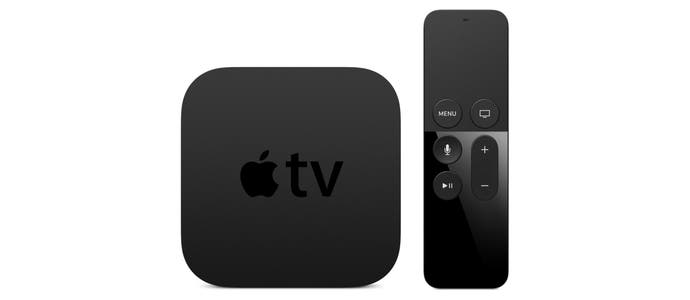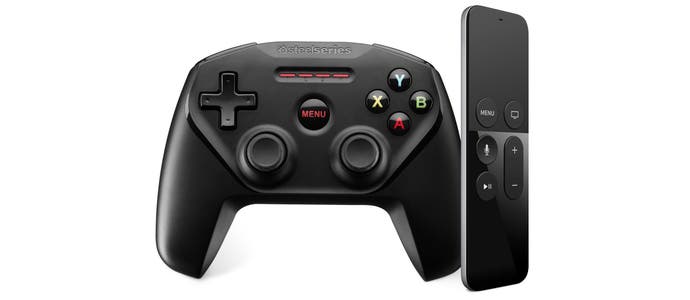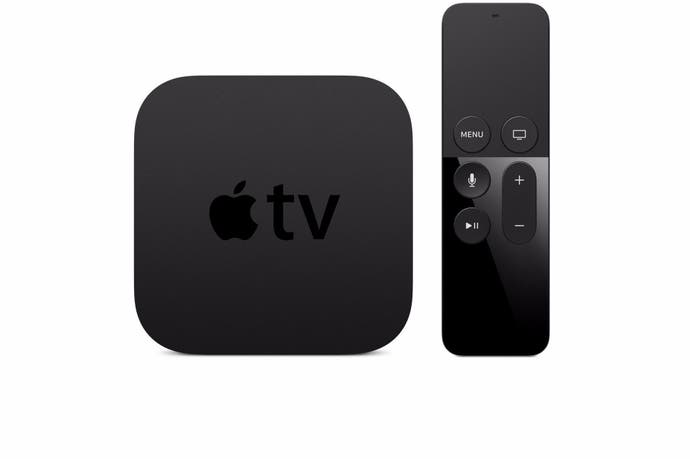Can the new Apple TV succeed as a games machine?
Digital Foundry dissects the hardware make-up of Apple's debut micro-console - and the gaming opportunities it offers.
The press has been speculating about it for years now, but on Wednesday we finally got to see Apple's debut game console - a not totally unexpected revamp of the Apple TV, bringing it with a radically revised interface, access to the App Store, and a Wii-inspired waggle remote. And thankfully we saw games too - a mixture of established mobile hits, more traditional console games and more tantalisingly, fully exclusive titles. But the sting in the tale is this: Apple TV is both a set-top box and a micro-console - jack-of-all-trades products that have thus far failed to enthuse the mainstream.
Perhaps the biggest challenge facing Apple is the status of the set-top box itself - and whether we actually want or indeed need one. The Smart TV revolution has thus far failed to birth a new gaming platform, but there's a very strong argument that it has reduced the amount of bespoke boxes we need tucked beneath our living room displays. NetFlix, Amazon Instant Video, BBC iPlayer - these services dominate the majority of our media consumption and a Smart TV is dead in the water if it does not support them. Elsewhere, 1080p-capable media streaming boxes have collapsed in price to the point where Rupert Murdoch is practically giving them away.
Meanwhile, at the other end of the spectrum, top-tier games machines that also offer advanced media playback experiences have also failed to gain traction. The most spectacular case in a point is Xbox One - a machine built around the concept of the closest integration yet between gaming and media. As good as the Kinect functionality is, the basics are really all we need. Elsewhere, much cheaper offerings more in line with the Apple TV's feature set have also underwhelmed, Amazon's Fire TV foremost amongst them.
There's the very real sense that Apple's pitch last Wednesday was somewhat incomplete - we are told that apps are the future of the TV experience, and yet nothing tangibly new was shown that elevates Apple TV beyond what is on the market already. The bottom line is this - if we know about NetFlix, iTunes and Hulu already, the chances are we already own perfectly serviceable hardware capable of watching them. Apple TV can only improve in terms of the user interface and discoverability - it can't improve the quality of the content it streams.

But of course, media commentators across the spectrum have a history of getting it wrong when it comes to assessing the prospects of Apple's new offerings, and there are good reasons why the new Apple TV may succeed where others fail. First of all, there is the ubiquity of the iOS platform, and the combined ingenuity of thousands of developers seeking to carve out a niche on the crowded platform. If there's an Apple TV killer app to be made, there's a decent possibility that the legions of developers on the App Store will find it even if Apple itself cannot.
There's also the very real possibility that the busy, vibrant, chaotic App Store games market could naturally expand to the larger screen. Existing purchases in your iTunes account could in theory run on the living room device - Asphalt 8 and Galaxy on Fire 2 were showcased at the presentation last week, for example. The notion of an existing library of games for the new console should at least factor into a prospective buying decision (though we suspect that many games will not translate well, and may not be compatible at all). On top of this, in the mobile/micro-console space, iOS is the closest developers will get to a fixed platform - which has all manner of advantages.
And finally, there is the halo factor surrounding Apple devices - the firm's ability to make its audience want its products even when there is no actual need for them, though Apple's success rate here isn't as consistent as once it was. The aura hasn't diminished in terms of its smartphone releases, but it's fair to say that the Apple Watch hasn't quite found the momentum hoped for and as for the new Apple TV, there was little in the presentation that we haven't seen before on existing hardware in some shape or form. But of course, that's nothing new - Apple's MO is to take existing ideas and refine them into something approaching the finished article, after all.
On top of that, the technical make-up of the remote itself is intriguing. There's little doubt that navigation will be much smoother and more intuitive compared to existing Smart TV devices. From a gaming perspect, clearly cues have been taken from the Wiimote in terms of the waggle factor, courtesy of its accelerometer and gyroscope. And what it lacks in terms of useable buttons, it attempts to address with a smooth, glass trackpad. It's going to be challenging to develop traditional gaming titles with this interface in mind, but adjusting there is nothing new for App Store developers and there should be enough commonality with the iPhone and iPad to make viable cross-platform releases across both smaller and larger screens. That said, the lack of Apple's 3D Touch haptic feedback system in the remote does seem somewhat short-sighted, and it's a criticism that could be levelled at the core spec of the unit itself.

A company looking to unleash a new games platform onto the market should be looking to give developers as much to work with as possible, and also sending out the message to consumers that they won't need to upgrade their device in the next year or two. And this makes the decision to utilise the existing A8 processor somewhat puzzling. It is already superseded by the iPhone 6S's A9 (1.8 times faster) and even if production capacity on the new chip was limited, Apple also had access to the A8X found in the iPad Air 2 - a processor with the theoretical GPU power to top last-gen consoles.
But in equipping the new Apple TV with older tech, there is the feeling that the firm isn't quite 'all in' on its games strategy - and it's difficult to avoid the sense that the device could become out-dated sooner rather than later. As things stand, the end result is that at a technological level, the A8 won't be supplying 3D experiences on par with Xbox 360, let alone Xbox One. The firm's insistence on sticking with relatively meagre levels of flash storage - 32GB as a base with usual eye-watering mark-up for the 64GB model - also limits the kinds of games we will be playing on it.
But if there's the sense that Apple isn't fully committed on a hardware level, we must always remember that spec is only a single component of a games machine - and certainly not the most important to the long-term success of a platform. In showcasing Harmonix's exclusive title for the new device - Beat Sports - Apple impresses both in its choice of developer and in recognising the need to showcase what the bespoke remote is capable of (and let's hope that the game is included in the box), while the Crossy Road multiplayer demo was a simple, but perfectly executed expansion to the core game that could work well in transforming a solitary mobile experience into a fun slice of living room gaming. Those titles, along with the other showcased at the presentation (and indeed, on the website, tell us everything we need to know about Apple's focus - basically that it believes in an evolution of the kind of 'bite-sized' gaming that has come to define the App Store. What's interesting here is that a console - even a micro-console - is fundamentally a very different proposition to a smartphone or tablet, and we suspect that the aggressive F2P model simply won't work. It's interesting to note that the titles showcased do appear to be more higher-end, paid-for products.
Overall, with the new Apple TV, we're firmly in micro-console territory, albeit with gaming as a component of the overall offering as opposed to its raison d'etre - in effect, it's an extension of the strategy that has served Apple so well in the smartphone and tablet markets. But our key concern about the device's fortunes is this: Apple proved the indispensable utility of its existing devices - to the point where one or more of them is usually within close personal proximity for most if not all of the day. By contrast, the jury's definitely still out on just how essential a $150 media streamer is, and to what extent we even need one when media playback is so ubiquitous across a vast range of existing devices we already own. Each component of the Apple TV will need to be extremely impressive to make an impact - and that includes the games.









